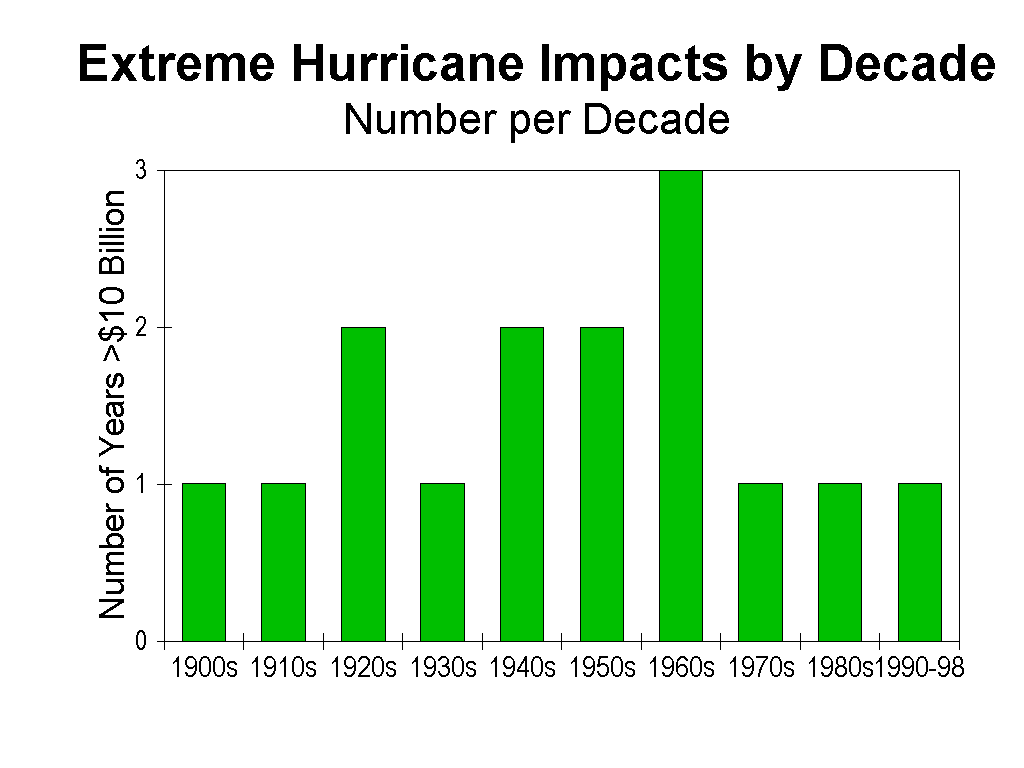 Back to Tropical Cyclones
Winds Page
Back to Tropical Cyclones
Winds Page | Back
to Main FAQ Page
Subject: D5) How does the damage that hurricanes
cause increase as a function of wind speed?
Contributed by Chris Landsea (NHC)
Or to rephrase the question: Would a minimal 74 mph hurricane
cause one half of the damage that a major hurricane with 148 mph
winds? No, the amount of damage (at least experienced along the
U.S. mainland) does not increase linearly with the wind speed.
Instead, the damage produced increases exponentially with the winds.
The 148 mph hurricane (a category 4 on the Saffir-Simpson Scale)
may produce - on average - up to 250 times the damage of a minimal
category 1 hurricane!
Pielke and Landsea (1998)
analyzed the damage caused by various categories of U.S.
landfalling tropical storms and hurricanes after normalizing by
the inflation rate, increases in wealth and coastal population
changes. Tropical cyclones from 1925 through 1995 were
tabulated in terms of 1995 U.S. dollars.
The following table summarizes the findings:
| Intensity |
Cases |
Median Damage |
Potential Damage * |
| Tropical/Subtropical Storm |
118 |
less than $1,000,000 |
0 |
| Hurricane Category 1 |
45 |
$33,000,000 |
1 |
| Hurricane Category 2 |
29 |
$336,000,000 |
10 |
| Hurricane Category 3 |
40 |
$1,412,000,000 |
50 |
| Hurricane Category 4 |
10 |
$8,224,000,000 |
250 |
| Hurricane Category 5 |
2 |
$5,973,000,000 |
500 |
* The "Potential Damage" values just provide a reference
value if one assigns the median damage caused by a category 1
hurricane to be "1". The rapid increase in damage as the
categories go up is apparent. (The value for Category 5
hurricanes in brackets may not be representative of true amounts
because of the very small sample [two] available.)
Other interesting findings:
- Mean annual damage in mainland US is $4,900,000,000.
- The worst U.S. hurricane damage - after normalizing to today's
population, wealth and dollars - is no longer Hurricane Andrew, but
is instead the 1926 Great Miami Hurricane. If this storm hit in
the mid-1990s, it is estimated that it would cause over $70 BILLION
in South Florida and then an additional $10 BILLION in the Florida
panhandle and Alabama.
- The United States has at least a 1 in 6 chance of experiencing
losses related to hurricanes of at least $10 BILLION on average.
- Even though the major hurricanes (the category 3, 4 and 5
storms) comprise only 21% of all US landfalling tropical cyclones,
they account for 83% of all of the damage.
- Damages have NOT been on the increase once one normalizes for
inflation, wealth, and coastal population changes. Instead one
sees that hurricane damages that were fairly low during the first
two decades of the 20th Century, quite high in the 1920s and
1940s to 1960s, and substantially lower in the 1970s and 1980s.
Only during the early 1990s does damage approach the high level
of impacts seen back in the 1940s through the 1960s. Thus
recent hurricane damages are NOT unprecedented.

Back to Tropical Cyclones
Winds Page | Back
to Main FAQ Page
|

